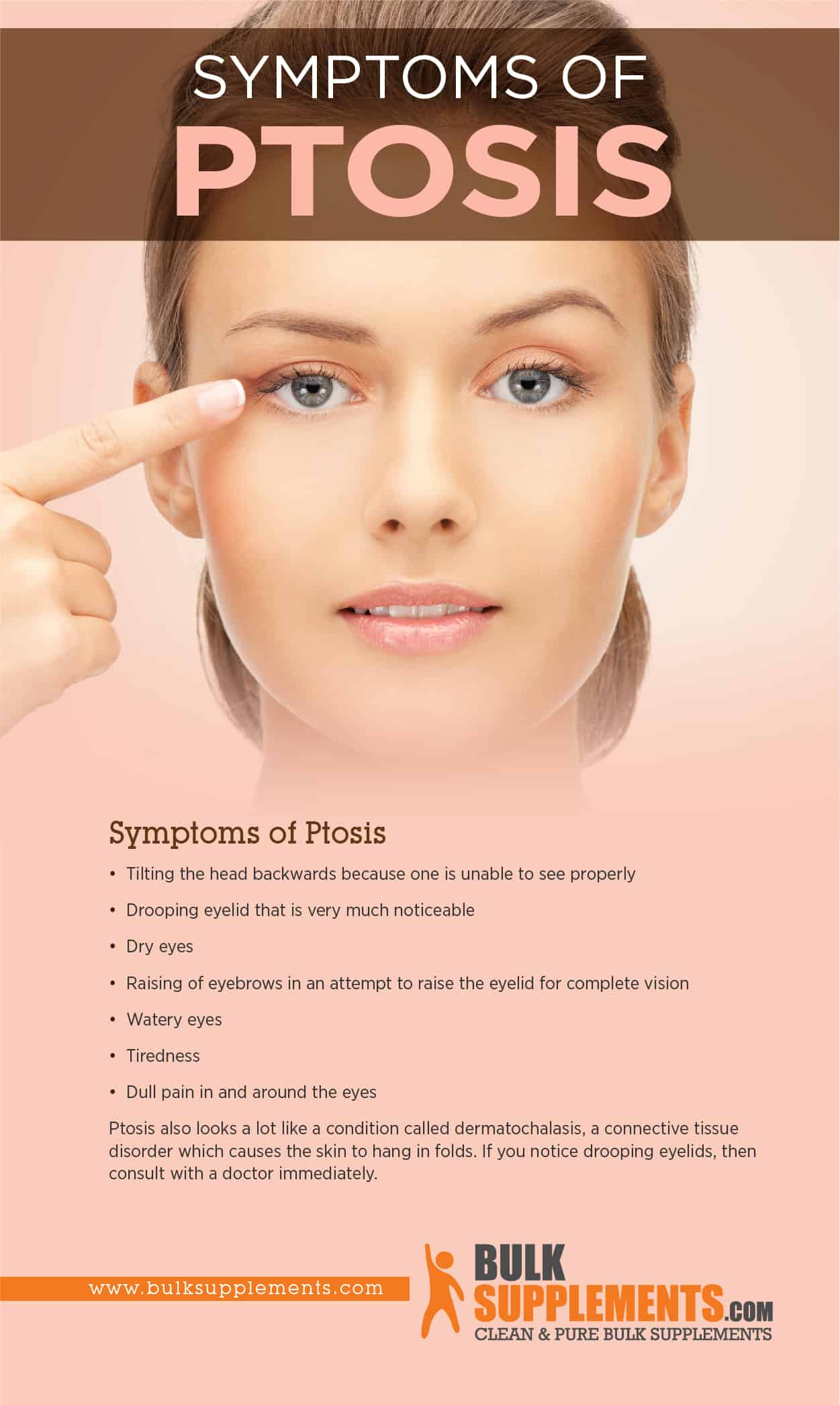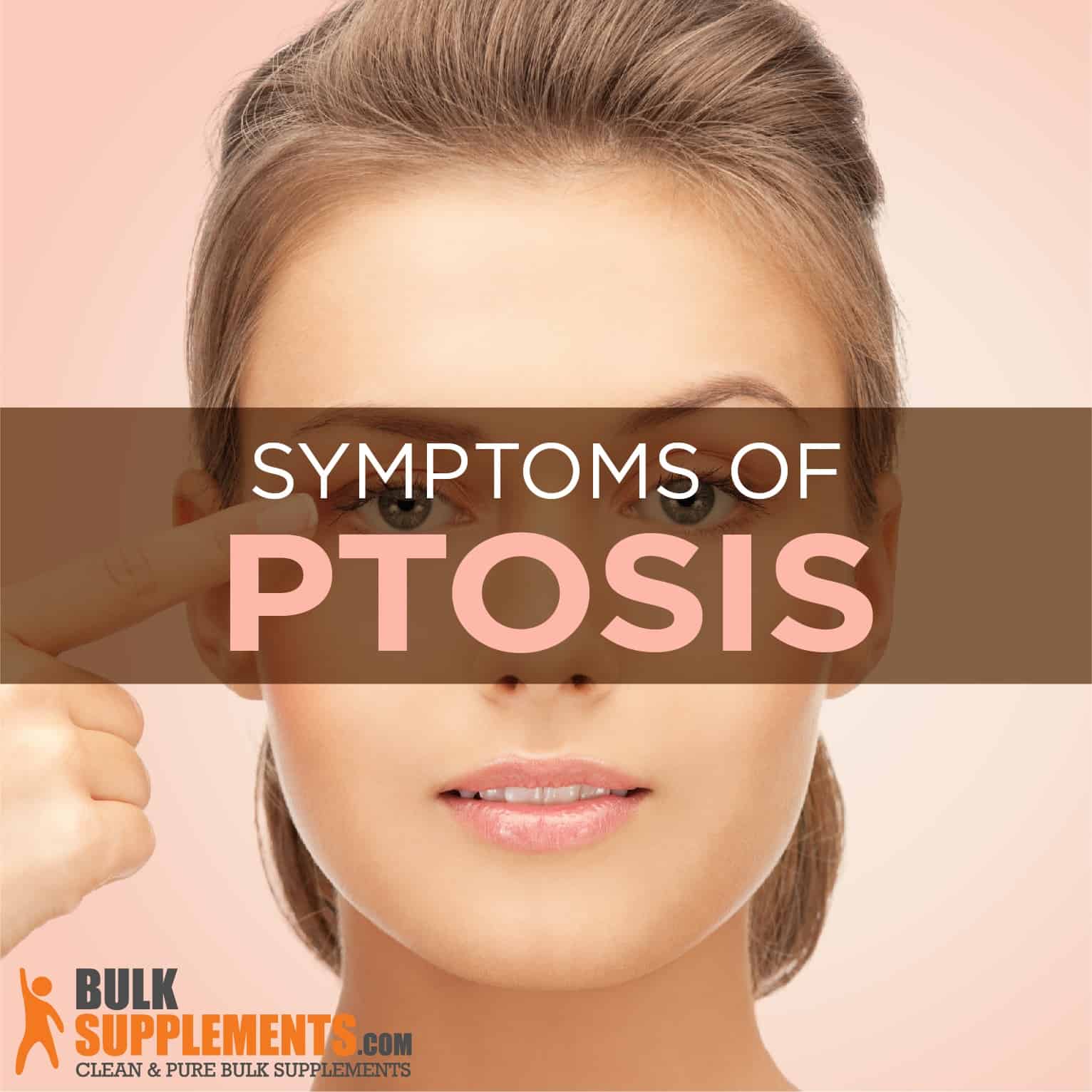What is Ptosis?
Ptosis, or droopy eyelids, is when your upper eyelids begin to droop downward. The cause is because of various factors such as age, genetics and damage caused to your eye or eyes. A lot of times, this is because of some affliction (weakening or malfunction) of the levator muscle, the one responsible for lowering and raising the eyelid. (x)
Types of Ptosis
- Neurogenic Ptosis
This type of ptosis occurs when the neural pathways that control the movement of eyelids get affected. Several underlying causes can cause this, including myasthenia gravis, Horner syndrome and third nerve palsy.
- Aponeurotic Ptosis
Aponeurotic ptosis is the standard type that develops because of aging. In this case, the levator muscle gets too overstretched, making it hard to return to its original form. Excessive use of contact lenses and frequent rubbing of the eyes may be the cause.
- Myogenic Ptosis
In this type, the muscles begin to weaken, which can occur because of systemic disorders like muscular dystrophy. The weakened muscles include the levator muscle, which triggers the drooping of the eyelid.
- Traumatic Ptosis
An injury or trauma to the eye or eyelid can also cause ptosis. When playing sports, taking care of the eyes with proper eye protection is essential. Such sports as racquetball and hockey need eye guards.
- Mechanical Ptosis
If the eyelid gets weighed down by any excess skin or mass, mechanical ptosis can occur. Mechanical ptosis means the drooping of the eyelids is gravity-related because the eyelids are so heavy. Also, trauma to the eyeball can cause this as well. (x)
- Congenital Ptosis
This type of ptosis consists of a child being born with droopy eyelids. Drooping eyelids happen because the levator muscle fails to develop correctly in the womb during pregnancy. Ensure the child has good vision, then the doctor recommends surgery. If not treated, it can cause poor permanent vision, and a condition called lazy eye. Children who have congenital ptosis should undergo a regular examination from an eye specialist every year. As the child begins to grow, the shape and size of the eye also change and can worsen with time. (x)
Causes and Risk Factors of Ptosis
Ptosis is typically the cause of aging, but there are also many underlying health conditions and concerns that can cause it, such as: (x)
- Injury
- Trauma
- Age
- Tumor or infection of the eyelid
- Tumor present inside the eye socket
- Diabetes
- Issue with levator muscle
- Side effect of cataract surgery
- Side effect of corrective eye surgery
- Muscular disorders like muscular dystrophy
- Brain tumor
- Myasthenia gravis
- Stroke
- Bell’s palsy
- Horner’s syndrome
- Brain aneurysm
- Side effect of Botox injection
- Nerve cancer
- Eye surgery
- Excessive eye rubbing
- Contact lenses (x)
Eye Strain Leading Cause of Ptosis
Eye strain can be a leading cause of this condition. Because of the vast amount of time spent staring at computer screens and phones for hours with abnormal light conditions, strains and tension with the eyes are common. To avoid eyestrain, make it a point to look away from the device every few minutes, blink a few times and focus on something else. (x)
Symptoms of Ptosis
Here are some symptoms to consider that may help you prevent or treat your drooping eyelid:
- Tilting the head backward because one is unable to see properly
- Drooping eyelid that is very much noticeable
- Dry eyes
- Raising of eyebrows in an attempt to raise the eyelid for complete vision
- Watery eyes
- Tiredness
- Dull pain in and around the eyes
Ptosis also looks a lot like a condition called dermatochalasis, a connective tissue disorder that causes the skin to hang in folds. (x) If you notice drooping eyelids, then consult with a doctor immediately.
Ptosis Treatment
Before beginning with the treatment process, a proper diagnosis is necessary to identify a potential underlying cause. Diagnosis can include a detailed discussion of your medical history, physical examination, eye examination, CT scans, MRI or blood tests. The purpose of these many tests is to adequately rule out underlying muscle disorders, neurological conditions and autoimmune diseases.
Surgery may help if the ptosis is so severe that the drooping of eyelids is causing limited vision. The surgeon attempts to lift the eyelids by tightening the levator muscles to improve eye appearance and vision in the surgical procedure. (x)
Like all surgical procedures, there are many risks associated with them. The eyelids may appear asymmetrical, or a person may lose the ability to move the eyelids. Some other serious complications can include hematoma and scratched cornea. Thus, you must select a surgeon experienced with eye surgeries.
Another effective and nonsurgical way of treating ptosis is the use of eyeglasses. Some special eyeglasses contain a crutch that holds up the drooping eyelids for proper vision. These crutches attach to the inner portion of the glasses in such a way that they are not noticeable. The use of these eyeglasses is relatively safe and effective, but getting used to them may take a while. The only side effect is that it can cause dry eyes because the crutches will keep the eyelids open. You have to make sure to follow the directions given by your ophthalmologist to keep the eyes lubricated.

Natural Remedies for Ptosis
Discovering natural remedies is easier on your body. Though they are not a quick fix, they conform to the natural flow of your body. Regarding nutritional treatments, you should consult with your healthcare provider first before trying any new supplement. Here are some to consider before surgery:
- Acupuncture
If the cause of ptosis is Bell’s palsy, a neuromuscular condition or a stroke, then the use of acupuncture may help. The acupuncturist will place the needles on the scalp and facial muscles to stimulate the muscles present in the face. This treatment is long term, and it may require you to visit the acupuncturist twice a week for a couple of months. (x)
- Tea Bag Eye Compress
To help with the symptoms of ptosis and ease the discomfort, soak some chamomile tea bags and cool them to room temperature. Squeeze excess tea out of the tea bags and place the bags on the eyes. Be careful to put some towels behind the head to prevent clothes and bedsheets from getting stained.
Research shows that chamomile tea is good for fighting off inflammation and calming the nerves. The tea is highly beneficial for treating eye inflammation because of the presence of various phytochemicals. When topically applied, it can help treat multiple eye infections, blocked tear ducts, and other eye issues.
When consumed as a tea, chamomile has anti-cancer properties. It also soothes the gastrointestinal tract, helps fight off a cold and controls blood sugar in those with diabetes. For optimum benefits, take 800 mg once or twice daily. (x)
- Vitamin B12
Vitamin B12 is an essential nutrient for the proper functioning of neuromuscular tissues. If you are a vegetarian, then you may be deficient in this vitamin. If you cannot consume meat, then try taking supplements to overcome the deficiency. To increase the intake of this vitamin in your diet, consume wild-caught animals like salmon, tuna or mackerel.
Where to Buy Supplements for Ptosis?
You can purchase these supplements for ptosis at BulkSupplements.com. The company is an industry-leading manufacturer and distributor of pure dietary supplements.
BulkSupplements.com is not just a consumer brand. It also supplies pure ingredients to other food and supplement brands to make their products. All products at BulkSupplements.com are manufactured and tested according to current and proper manufacturing practices.
Are you interested in trying any of these powders or supplements mentioned in this article as a possible solution to helping you with ptosis? Contact BulkSupplements.com to place an order today.
Eyelid Strengthening Exercises
If aging and a decrease in muscular strength causes ptosis, doing special exercises for the eyelids can tone down the droopiness and improve the overall appearance of the eyes. To exercise:
- Shut both of your eyes and keep a finger on the base of the eyelid.
- Try to open your eyes as much as possible.
- Repeat this exercise almost 15 times.
If that doesn’t work, try standing in front of the mirror. Put an index finger on the upper part of the eyelids or the lower area of the eyebrows. Raise the fingers up against the brow bone and close both eyes. Blink your eyes a few times and squeeze the eyes shut for a few seconds. Repeat this exercise almost ten times a day. (x)
Netrapana Therapy
Netrapana therapy in Ayurvedic medicine dates back thousands of years. It involves consuming a healthy diet (with herbal remedies) and living a generally healthy lifestyle to treat various conditions. The treatment of ptosis with Ayurvedic medicine includes pouring a combination of warm ghee (clarified butter), certain oils and salt over the eyes by a professional. It is a soothing treatment that can calm the nerves and muscles present in the eye area. Look for a professional with experience in netrapana therapy.
Eat Eye-Friendly Foods
Carotenoids and beta carotene are two components that are associated with good eye health. For people with ptosis, consuming foods rich in beta carotene can help fight off inflammation, boost the immune system, protect from various cancers, and undo skin damage. When preparing a meal plan, make sure to include foods that are rich in beta carotene.
You can quickly identify foods rich in carotenoids because of their taste and fresh, bright colors. Consume fruits that are bright orange, yellow and red. These can include tomatoes, bell peppers, papaya and winter squash.
Precautions Concerning Ptosis
If your eyelids start to droop out of the blue, accompanied by any of the following signs, then seek emergency medical help:
- Double vision
- Eye infection
- Fever
- Bulging eye
- Migraine headache
- Pain in the eye area
- Muscle weakness, even in arms and legs
The Bottom Line
Ptosis reflects a condition associated with the eyes, usually caused by aging; however, if you notice drooping eyelids out of the blue and it develops quickly, it may be a sign of a severe health condition. The extreme health concern can include migraine, diabetes, stroke, brain tumor, cancer, aneurysm or another medical issue.
Drooping eyelids can occur in only one eye or both, and sometimes it is so severe that it can affect vision to a great extent. In extreme cases, surgery is necessary to treat this condition.
Some children are also born with ptosis at birth, and not getting it treated can exacerbate vision issues for an entire lifetime. Treatment for ptosis includes both surgical and nonsurgical options like a healthy diet, supplements and eye strengthening exercises.
These statements have not been evaluated by the Food and Drug Administration. These products are not intended to diagnose, treat, cure or prevent any disease.


